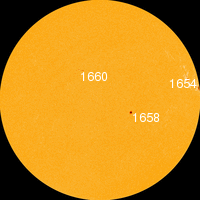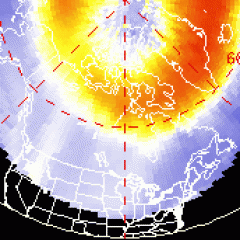JUPITER-MOON CONJUNCTION: When the sun goes down tonight, step outside and look east. The Moon and Jupiter are converging for a tight conjunction on Monday evening, Jan. 21st. Most sky watchers will see the two bright bodies just a fraction of a degree apart. Observers in parts of South America will witness an even closer encounter--an occultation, in which the Moon passes directly in front of Jupiter. Sky maps: Jan. 20, 21.
CME IMPACT + MICROBIAL LIGHTS: A coronal mass ejection hit Earth's magnetic field on Jan. 19th at approximately 17:15 UT. The weak impact did not trigger a full-fledged geomagnetic storm, but it did illuminate the Arctic Circle with auroras. Frank Olsen photographed the display from a beach in Sortland, Norway; scroll past his picture to learn about the glittering lights in the sand:
The lights in the sand are bioluminescent dinoflagellates, a type of naturally glowing microbe. "To my surprise, I found these guys floating around on the beach tonight," says Olsen. "They looked great together with the auroras in the sky."
There is an interesting link between the auroras and the dinoflagellates. Both use oxygen to create their glow. In the case of the marine organism, a chemical pigment (luciferin) reacts with oxygen to create light. Meanwhile up in the sky, charged particles from the solar wind rain down on the atmosphere, colliding with oxygen molecules to create the telltale green hue of auroras.
More lights are possible tonight. NOAA forecasters estimate a 55% chance of polar geomagnetic storms as Earth passes through the wake of the CME. Aurora alerts: text, voice.
![]()

![]()
Solar wind
speed: 390.1 km/sec
density: 2.6 protons/cm3
explanation | more data
Updated: Today at 1826 UT
![]()
X-ray Solar Flares
6-hr max: C1 1432 UT Jan20
24-hr: C1 1432 UT Jan20
explanation | more data
Updated: Today at: 1800 UT
![]()
![]()
![]()
Daily Sun: 20 Jan 13
![]()
![]()
Departing sunspot AR1654 no longer poses a threat for Earth-directed solar flares. Credit: SDO/HMI
![]()
![]()
![]()
Sunspot number: 46
What is the sunspot number?
Updated 20 Jan 2013
Spotless Days
Current Stretch: 0 days
2013 total: 0 days (0%)
2012 total: 0 days (0%)
2011 total: 2 days (<1%)
2010 total: 51 days (14%)
2009 total: 260 days (71%)
Since 2004: 821 days
Typical Solar Min: 486 days
Update 20 Jan 2013
The Radio Sun
10.7 cm flux: 107 sfu
explanation | more data
Updated 20 Jan 2013
![]()
![]()
![]()
Current Auroral Oval:
Switch to: Europe, USA, New Zealand, Antarctica
Credit: NOAA/POES
![]()
![]()
![]()
Planetary K-index
Now: Kp= 1 quiet
24-hr max: Kp= 3 quiet
explanation | more data
![]()
Interplanetary Mag. Field
Btotal: 2.5 nT
Bz: 1.2 nT north
explanation | more data
Updated: Today at 1825 UT
![]()
![]()
![]()
Coronal Holes: 20 Jan 13
![]()
![]()
Solar wind flowing from this southern coronal hole should read Earth approximately six days from now. Credit: SDO/AIA.





